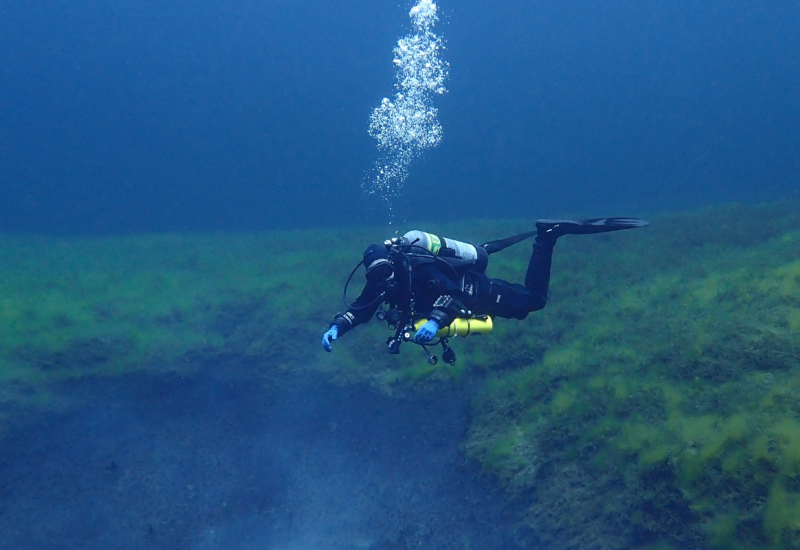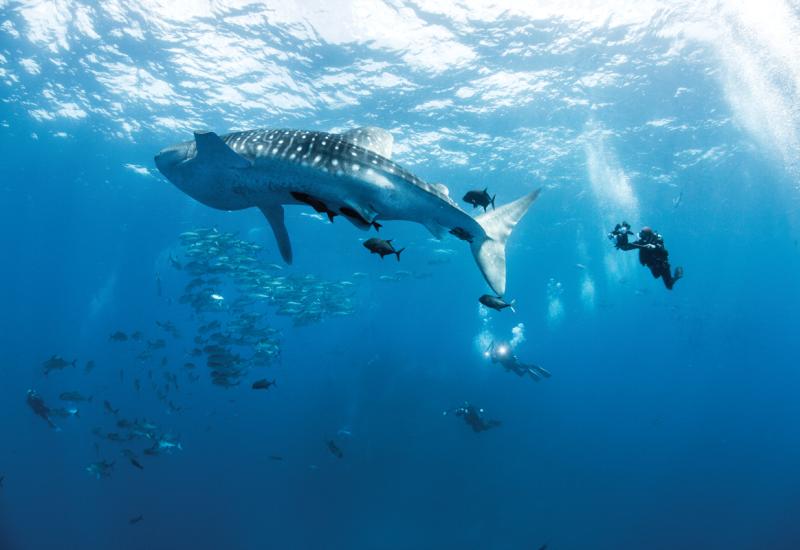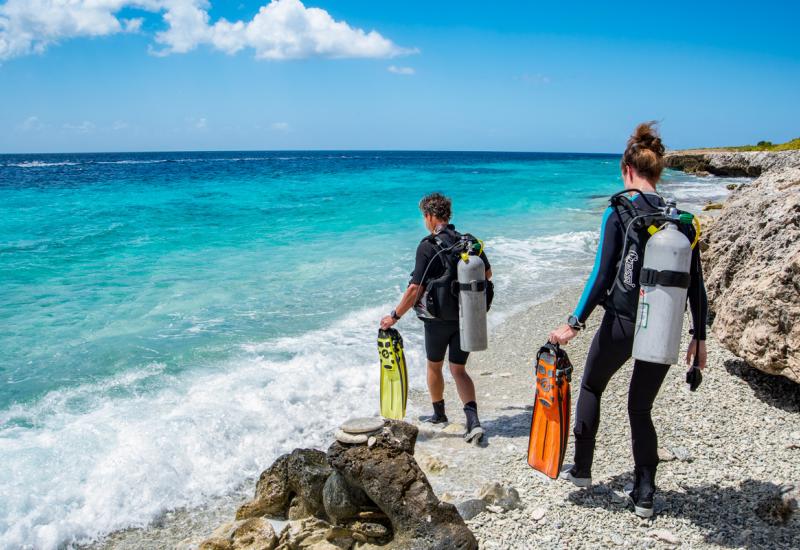Ask An Instructor - August 2007
August 2007
By Michael Ange
Q: During my certification class, I had problems clearing my mask. I practiced and practiced, but still had difficulty. On my checkout dives, I still had trouble and, on my last dive, my instructor actually had to hold me down to keep me from rushing to the surface. I now have more than 300 logged dives, and in spite of repetitive practice, I still have difficulty breathing through my mouth when my nose is exposed to water. I feel like I cannot get any air and if I do get air, I can't blow enough of it out of my nose to actually clear my mask. I know I need to master this safety skill. Can you help?
A: Let me start by saying that what you have described is a very common problem for new divers. It's hard to know exactly what you're doing wrong without seeing it, but based on what you're saying, the issue is probably psychological and not a real skill problem. Many divers can swim along happily for hours as long as their mask is securely in place. But even a little trickle of water into their mask can create a level of anxiety that makes it very difficult to respond to any problem. This is a major safety issue for divers and a problem that should be fully resolved before anyone is certified. There are some skills that you can practice in a safe, shallow, confined-water area with the supervision of a buddy to improve your comfort and help resolve your problem. Although it may sound obvious, it is important for you to understand on an intellectual level that your regulator functions the same whether you are wearing a mask or not. Before you start, you must trust that your equipment will deliver adequate air.
Skill Number One: Standing in water no more than chest-deep, with all of your equipment in place except for a mask, kneel down so that your face is slightly under the water and practice breathing from your regulator until you can do this comfortably for at least two minutes. If you wear contact lenses, or if the water really bothers your eyes, you can either keep your eyes closed (preferable) or use goggles that do not enclose the nose. If you have to, hold your nose initially, but the goal is to kneel comfortably on the bottom for two minutes or more without holding your nose, sucking in water or having to suppress the urge to panic. It is best to breathe in through your mouth and out through your nose during this exercise, because it will keep the water out of your nose, and it replicates what you must do to clear your mask. Once you have mastered this skill, practice it again with your mask in your hand. At the end of the two minutes, instead of standing up, put your mask on, clear it, and swim around a bit before you come up.
Skill Number Two: In the same shallow water, have your buddy position himself about 50 to 75 feet away with your mask in his hand or lying at his feet. Submerge and stay in one place, breathing on your regulator until you are comfortable. Then swim to your buddy, put your mask on and clear it. Swim back to your starting point before you surface. Do not move on to skill number three until you have mastered both of these skills.
Skill Number Three: For this skill, it's a good idea to work with a qualified and certified divemaster or instructor. You need to be in confined clear water that is eight to 12 feet deep and no deeper. Drop to the bottom, take a few moments to get comfortable and then remove your mask. Kneel on the bottom and breathe in through your mouth and out through your nose for two minutes, then put on your mask and clear it. Remain on the bottom for another minute or two and then slowly and safely ascend to the surface. Only after you have mastered this skill, should you attempt the final skill: tossing your mask into the deep water about 30 to 40 feet from where you are, then descend to the bottom, swim to your mask, put it on, and attempt to clear it again. After it is clear, swim slowly back to the starting point and slowly ascend.
Of the hundreds of students with mask clearing problems that I have trained, 95 percent or more find that somewhere during the process of mastering these skills, they get comfortable, and the daunting task of mask clearing is suddenly no longer a challenge.
Q: Although I never get seasick, even on bumpy boat rides, every time I dive at night I get sick to my stomach. What can I do?
A: Generally speaking, motion sickness results from a disagreement between your eyes and your body--your body senses that it is moving, but your eyes say that you are not. A couple of factors, anxiety and weightlessness, may decrease your resistance to motion sickness while diving at night. Most divers have a healthy respect, if not fear, for what may be lurking beyond their limited range of vision, and this added stress can make you more susceptible to getting sick. Being weightless can also aggravate motion sickness by limiting how your body senses gravity, which your body uses to determine its position and stability in the environment. Additionally, when you dive at night, you have a more limited field of vision and as a result, you may lack the visual reference necessary to see that you are moving with current or surge. You may not experience the same sensation when diving in the daytime, especially if you are diving in shallow water, because you have a much wider range of view. Here are a couple of strategies for preventing seasickness on a night dive.
Use a brighter dive light with a broader beam--it will increase your field of vision. Begin your night dives by descending on a fixed reference point like an anchor line all the way to the bottom, and use the line as a visual reference. After you descend, give yourself a few moments to get acclimated before swimming away. When you swim away, stay close to the bottom so that you have a substantial visual reference during the entire dive. Try to avoid ascending back to the surface in open water (i.e., come up an anchor line, if possible) and also try to avoid floating on the surface as much as possible, both when you enter the water and when you get ready to exit. If none of these strategies works for you, you may want to discuss medications with your doctor. Keep in mind that even mild over-the-counter medications can cause serious side effects when used while diving. Consult a doctor who is knowledgeable about diving physiology or another resource like the Divers Alert Network before selecting any medication.
Q: My instructor tells me that I need to build a save-a-dive kit. Do I really need it? If so, what should I include?
A: The equipment failures that most commonly ruin a diving day are also some of the most easily resolved. Mask straps, fin straps, and plastic weight belt buckles are among the items that fail on dive boats every day. Fortunately, these items are inexpensive, have a long shelf life and are easy to store. In many cases, low-cost generic straps are available and will work with your equipment, but beware: In some cases, especially with higher-end, brand-name products, the generics will not function properly. In those cases, have your authorized dealer get an exact match from the company that manufactured your equipment. If you wear fins with quick-release plastic buckles, it's a good idea to have an extra buckle or, better yet (since these things can be so hard to thread on the back of a rocking boat), just get a replacement strap that has the buckles already attached. Another good item to have is a little zip-close bag with a couple of spare tank O-rings. O-rings are cheap, and it's a good idea to have some available so you never have to dive with your tank-to-regulator connection leaking "just a little." Remember, it generally leaks a little before it begins to leak a lot.
Got a question you need answered?
E-mail it to [email protected], or write to Ask An Instructor, 6600 Abercorn St., Suite 208, Savannah, GA 31405.
August 2007
By Michael Ange
Q: During my certification class, I had problems clearing my mask. I practiced and practiced, but still had difficulty. On my checkout dives, I still had trouble and, on my last dive, my instructor actually had to hold me down to keep me from rushing to the surface. I now have more than 300 logged dives, and in spite of repetitive practice, I still have difficulty breathing through my mouth when my nose is exposed to water. I feel like I cannot get any air and if I do get air, I can't blow enough of it out of my nose to actually clear my mask. I know I need to master this safety skill. Can you help?
A: Let me start by saying that what you have described is a very common problem for new divers. It's hard to know exactly what you're doing wrong without seeing it, but based on what you're saying, the issue is probably psychological and not a real skill problem. Many divers can swim along happily for hours as long as their mask is securely in place. But even a little trickle of water into their mask can create a level of anxiety that makes it very difficult to respond to any problem. This is a major safety issue for divers and a problem that should be fully resolved before anyone is certified. There are some skills that you can practice in a safe, shallow, confined-water area with the supervision of a buddy to improve your comfort and help resolve your problem. Although it may sound obvious, it is important for you to understand on an intellectual level that your regulator functions the same whether you are wearing a mask or not. Before you start, you must trust that your equipment will deliver adequate air.
Skill Number One: Standing in water no more than chest-deep, with all of your equipment in place except for a mask, kneel down so that your face is slightly under the water and practice breathing from your regulator until you can do this comfortably for at least two minutes. If you wear contact lenses, or if the water really bothers your eyes, you can either keep your eyes closed (preferable) or use goggles that do not enclose the nose. If you have to, hold your nose initially, but the goal is to kneel comfortably on the bottom for two minutes or more without holding your nose, sucking in water or having to suppress the urge to panic. It is best to breathe in through your mouth and out through your nose during this exercise, because it will keep the water out of your nose, and it replicates what you must do to clear your mask. Once you have mastered this skill, practice it again with your mask in your hand. At the end of the two minutes, instead of standing up, put your mask on, clear it, and swim around a bit before you come up.
Skill Number Two: In the same shallow water, have your buddy position himself about 50 to 75 feet away with your mask in his hand or lying at his feet. Submerge and stay in one place, breathing on your regulator until you are comfortable. Then swim to your buddy, put your mask on and clear it. Swim back to your starting point before you surface. Do not move on to skill number three until you have mastered both of these skills.
Skill Number Three: For this skill, it's a good idea to work with a qualified and certified divemaster or instructor. You need to be in confined clear water that is eight to 12 feet deep and no deeper. Drop to the bottom, take a few moments to get comfortable and then remove your mask. Kneel on the bottom and breathe in through your mouth and out through your nose for two minutes, then put on your mask and clear it. Remain on the bottom for another minute or two and then slowly and safely ascend to the surface. Only after you have mastered this skill, should you attempt the final skill: tossing your mask into the deep water about 30 to 40 feet from where you are, then descend to the bottom, swim to your mask, put it on, and attempt to clear it again. After it is clear, swim slowly back to the starting point and slowly ascend.
Of the hundreds of students with mask clearing problems that I have trained, 95 percent or more find that somewhere during the process of mastering these skills, they get comfortable, and the daunting task of mask clearing is suddenly no longer a challenge.
Q: Although I never get seasick, even on bumpy boat rides, every time I dive at night I get sick to my stomach. What can I do?
A: Generally speaking, motion sickness results from a disagreement between your eyes and your body--your body senses that it is moving, but your eyes say that you are not. A couple of factors, anxiety and weightlessness, may decrease your resistance to motion sickness while diving at night. Most divers have a healthy respect, if not fear, for what may be lurking beyond their limited range of vision, and this added stress can make you more susceptible to getting sick. Being weightless can also aggravate motion sickness by limiting how your body senses gravity, which your body uses to determine its position and stability in the environment. Additionally, when you dive at night, you have a more limited field of vision and as a result, you may lack the visual reference necessary to see that you are moving with current or surge. You may not experience the same sensation when diving in the daytime, especially if you are diving in shallow water, because you have a much wider range of view. Here are a couple of strategies for preventing seasickness on a night dive.
Use a brighter dive light with a broader beam--it will increase your field of vision. Begin your night dives by descending on a fixed reference point like an anchor line all the way to the bottom, and use the line as a visual reference. After you descend, give yourself a few moments to get acclimated before swimming away. When you swim away, stay close to the bottom so that you have a substantial visual reference during the entire dive. Try to avoid ascending back to the surface in open water (i.e., come up an anchor line, if possible) and also try to avoid floating on the surface as much as possible, both when you enter the water and when you get ready to exit. If none of these strategies works for you, you may want to discuss medications with your doctor. Keep in mind that even mild over-the-counter medications can cause serious side effects when used while diving. Consult a doctor who is knowledgeable about diving physiology or another resource like the Divers Alert Network before selecting any medication.
Q: My instructor tells me that I need to build a save-a-dive kit. Do I really need it? If so, what should I include?
A: The equipment failures that most commonly ruin a diving day are also some of the most easily resolved. Mask straps, fin straps, and plastic weight belt buckles are among the items that fail on dive boats every day. Fortunately, these items are inexpensive, have a long shelf life and are easy to store. In many cases, low-cost generic straps are available and will work with your equipment, but beware: In some cases, especially with higher-end, brand-name products, the generics will not function properly. In those cases, have your authorized dealer get an exact match from the company that manufactured your equipment. If you wear fins with quick-release plastic buckles, it's a good idea to have an extra buckle or, better yet (since these things can be so hard to thread on the back of a rocking boat), just get a replacement strap that has the buckles already attached. Another good item to have is a little zip-close bag with a couple of spare tank O-rings. O-rings are cheap, and it's a good idea to have some available so you never have to dive with your tank-to-regulator connection leaking "just a little." Remember, it generally leaks a little before it begins to leak a lot.
Got a question you need answered?
E-mail it to [email protected], or write to Ask An Instructor, 6600 Abercorn St., Suite 208, Savannah, GA 31405.










